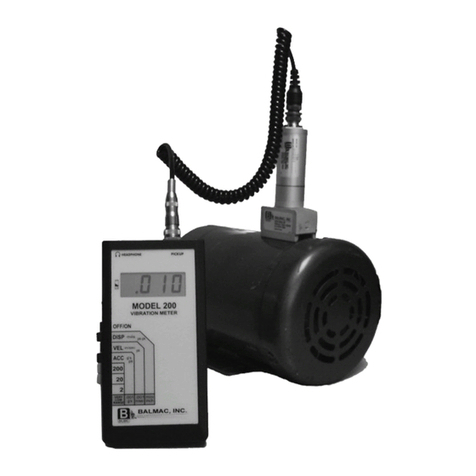
Page 4 MODEL 205 ce
SECTION 2 - FEATURES
Battery
The Balmac Model 205 ce Vibration Meters
come equipped with 4 Size AA 1.5 Volt standard
alkaline batteries. Alkaline batteries are
recommended for maximum operation time.
LOW BATTERY - a low battery symbol “Lo-Bat”
or “¹”, will display (with instrument power “ON”)
when the batteries needs replacement.
REPLACING BATTERIES - (procedure)
1. Turn the 205 ce “OFF”.
2. Remove two #4-32 Phillips-head screws
from back battery cover. Remove cover.
3. Locate battery holder and carefully remove
old batteries.
4. Insert new batteries as indicated by outlines
in bottom of battery compartment. Replace
cover and tighten screws.
Controls
1. OFF/ON (Grey) - Self-latching button powers
the Model 205 ce on and off.
2. DISP, VEL, ACC (Black) - Self-latching,
vibration amplitude buttons (see Section 4
“Measurements” for a detailed explanation of the
merits of each).
3. RANGE BUTTONS (200, 20, 2, Very Low
Range) (White) - Self-latching Full Scale Range
selector buttons. (205M ce = 2000, 200, 20
VLR).
Vibration Pickup
The Balmac Model 205 ce Vibration Meter uses
the Model 601 Pickup. The Model 601 connects
to the Model 059-5' Straight Pickup Cable (2-
conductor, shielded cable). The 059-5' cable
connects to the input connector at the top of the
Model 205 ce.
It is recommended that the Model 601 Pickup
be mounted on 1/4-28 UNF stud, or on the
Model 052 Magnetic Base Clamp.
NOTE: DO NOT SLAM OR BANG THE PICKUP
WHEN MOUNTING WITH THE MAGNETIC
BASE. THIS CAN DAMAGE THE PICKUP.
SECTION 3 - OPERATION
1. Connect the Model 601 Pickup to the Model
059-5' Pickup Cable.
2. Select appropriate mounting accessory
(Model 052 Magnetic Base Clamp) and connect
to the Model 601 Pickup.
3. Connect cable and pickup assembly to the
Model 205 ce.
4. Depress the OFF/ON switch to power the
instrument “ON”.
5. Select then depress one of the black
Amplitude Measurement buttons:
ACC = Acceleration = g’s (peak)(in/sec²)
205M ce = g’s mm/sec²
VEL = Velocity = Inches Per Second (peak)
205M ce = Velocity = mm/sec
DISP = Displacement = Mils (peak to peak)
205M ce = Displacement = µm
6. Select then depress one of the gray Range
buttons (2, 20, 200 or Very Low Range)(205M ce
= 20, 200, 2000 or Very Low Range). Change
the Range button to another range if necessary
until the AMPLITUDE meter reads without
indicating an overrange condition. (Over Range
Display = 1 __ __ __ [1 with 3 blank digits]).
Read vibration amount directly.
NOTE: The best recommended permanent
mounting method is using a stud on a clean flat
surface (like on the magnetic base).
CAUTION: The mounting stud must not extend
into the pickup more than 0.2". Hand tighten the
pickup. DO NOT WRENCH THE PICKUP
ONTO THE MOUNTING. The pickup’s axis of
sensitivity is perpendicular to the mounting base.
The pickup may be used and mounted in any
direction (horizontal, vertical, axial). See
Vibration Pickup specification on Page 11.





























